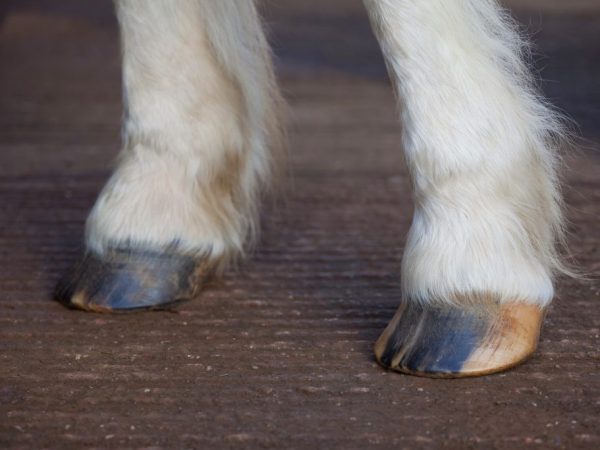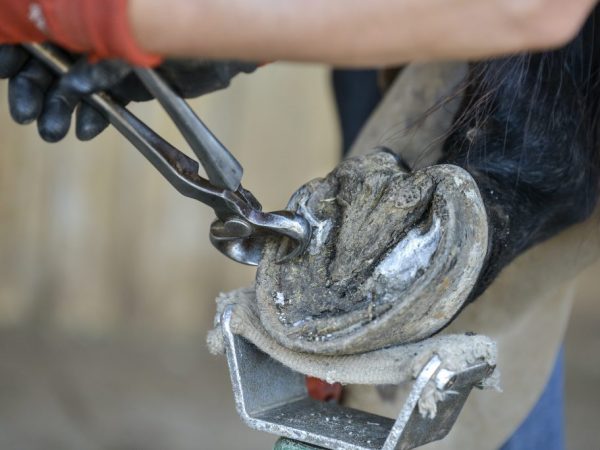How to properly trim hooves in farm goats
Not many people know that goats' hooves need to be trimmed twice a year. This procedure is important for all breeds at any age. Trimming the hooves of goats is not difficult, and with a certain skill it does not take much time.

Trimming hooves in farm goats
But you need to know how to do it correctly so as not to harm the animal. After all, if you cut too close to the body it can lead to blood poisoning and death of the pet.
Why you need to trim hooves in goats
It is necessary to trim the hooves of a domestic goat due to their constant growth. This is akin to human nails, if they are not cut, then they dig into the skin, cling and interfere with their owner in every possible way.
In the wild, the stratum corneum of the hoof is worn away by walking on rocks and rocks. Pets do not have this opportunity, especially in winter. When a goat hibernates in a barn on a soft bedding, the hoof grows even more.
When the horns grow on the hooves, the animal begins to experience discomfort. This can often lead to big problems:
- the wrapped horns of a grown hoof are often clogged with dirt and manure, which becomes a favorable environment for the development of infections and other pathogens, and decay of the hoof may begin;
- improper position of the legs with regrown hooves leads to dislocations of the limbs and even their fractures;
- the gait of the animal is disturbed, which is bad for the joints;
- lameness develops;
- due to improper positioning of the legs, the goat cannot eat and drink normally.
An animal with regrown hooves experiences pain and discomfort when walking, therefore it is more often in a supine position. This negatively affects the milk yield and the general condition of the animal.
Such manipulation as clipping the hoof is not a surgical type of treatment. But it still requires extreme caution and adherence to special rules.
When to trim hooves in goats?
Hoof trimming in domestic goats is done twice a year in late autumn and early spring. The importance of this procedure is undeniable. In the fall, the hooves are prepared for wintering on a soft litter and the lack of the ability to scrub the stratum corneum. In early spring, before the animal is taken to the pasture, hooves that have grown over the winter are removed.
A properly trimmed hoof should look like a kid's, white and sleek. It is more convenient to prune if the animals walked on wet snow or wet grass. In this case, the fatal layer swells and becomes more pliable.
Some breeders are replacing routine pruning by walking the herd on asphalt. Walking on rough surfaces for at least one kilometer a day can be a good alternative to pruning.
Hoof trimming tools

Be sure to stock up on a tool
You will need special equipment for trimming. It should be prepared in advance. Each breeder independently chooses a more convenient tool for their pets.If a person is performing the procedure for the first time, then it is better to stock up on several options:
- Hoof trimming scissors are handy during the trimming process. But when choosing, you should pay attention to the length of the handle. A handle that is too short will require more effort when cutting, while a long handle will, on the contrary, make things easier.
- The hoof knife is a convenient but dangerous tool. Not suitable for inexperienced breeders, as there is a high risk of injury to the arm during pruning if the goat jerks its leg.
- A regular knife must be very well sharpened, which also increases the likelihood of getting hurt by it. The grip should be comfortable and fit well in the palm of your hand.
- The garden pruner does an excellent job with the overgrown outer wall, but is not convenient for the inside of the hoof.
- Garden scissors remove the overgrown part well, but it is difficult to properly align the sole with them.
- Metal scissors, if they are sharp, can quickly deal with even the most neglected case.
- A hacksaw for metal quickly and effectively cuts off the overgrown parts, it is important when working with it to firmly fix the goat so that it does not injure itself.
- Regular household scissors are handy for removing small appendages between the toes, but are not suitable for trimming the entire hoof.
In practice, everyone chooses the most convenient tool for himself. How long pruning will last depends on the sharpness of the inventory and the skill of the breeder.
Preparing the goat for the procedure
For goats, clipping hooves is stressful, especially the first time. It is not recommended to carry out the procedure to pregnant females due to the threat of miscarriage. Her health needs to be taken care of before mating
If the goat has a calm disposition, then you can simply tie it with a rope and put it so that the rope is pulled around its neck. If the pet is agitated or has a violent character, then it will have to be knocked on its side. This will require an assistant, since it is unrealistic to cope with this task alone. The goat must be firmly pressed to the ground. To soothe it, you can stroke it or treat it with your favorite delicacy.
It must be remembered that the animal can bite strongly in a stressful situation for him. The head should be as far away from the person performing the manipulations as possible.
How to trim hooves in goats
This procedure is not complicated, but it requires some experience. If a breeder is faced with pruning for the first time, then it is recommended to watch training videos, where the whole process is shown step by step.
The procedure must be performed carefully and as quickly as possible, so as to expose the pet to less stress. The tool must be sharpened well before trimming the hooves. There is a certain sequence of actions:
- Dirt and manure are removed from under the hoof horn. It is convenient to do this using a special hook. It is not recommended to use sharp objects at this stage in order not to harm the goat.
- The outer part of the build-up is cut off. It is hard and easier to remove with hoof scissors. If the surface is too hard and the instrument will not pick it up, then the hoof can be soaked in warm water using a bucket, bowl or saucepan.
- The heels are trimmed to the same level as the toes so that the hoof can grow properly in the future. It is better to start the procedure from the base of the heel.
- The base of the hooves is compared until it is flat and fairly flat. As soon as the soft pink part becomes visible, the pruning must be stopped, since there are already blood vessels below.
- Both fingers should be the same shape so that the goat does not limp or fall over.
- after the procedure, the hooves are soaked in a solution of creolin or copper sulfate to disinfect tissues and prevent infection.
- If there are signs of hoof rot, then they should be carefully cleaned and trimmed.
If the hoof is trimmed correctly, then the goat stands on it at a 45 degree angle. During the procedure, blood vessels or soft tissues of the legs may be affected.This happens by mistake of the breeder, but the situation can be corrected. To do this, the damaged area is treated with hydrogen peroxide, and then with iodine. The pet is transferred to a separate stall with dry bedding until the wounds heal.
When cleaning and trimming the hooves, signs of hoof rot may be found.
This is very dangerous for the animal, as it threatens problems with the musculoskeletal system. A sick goat is transferred to a separate pen and provided with clean, dry bedding and complete food. For the prevention of hoof rot, goat willow infusion is used. Hooves are soaked in it after cleaning and trimming.
Timely trimming of hooves allows you to maintain the health of pets, as well as increase milk yield. If a goat is worried about the hooves, then it will be much worse to milk. Hoof trimming in adult goats is a preventative measure for leg ailments. It is necessary to cut off the hardened beginner bone tissue on the hooves regularly.


